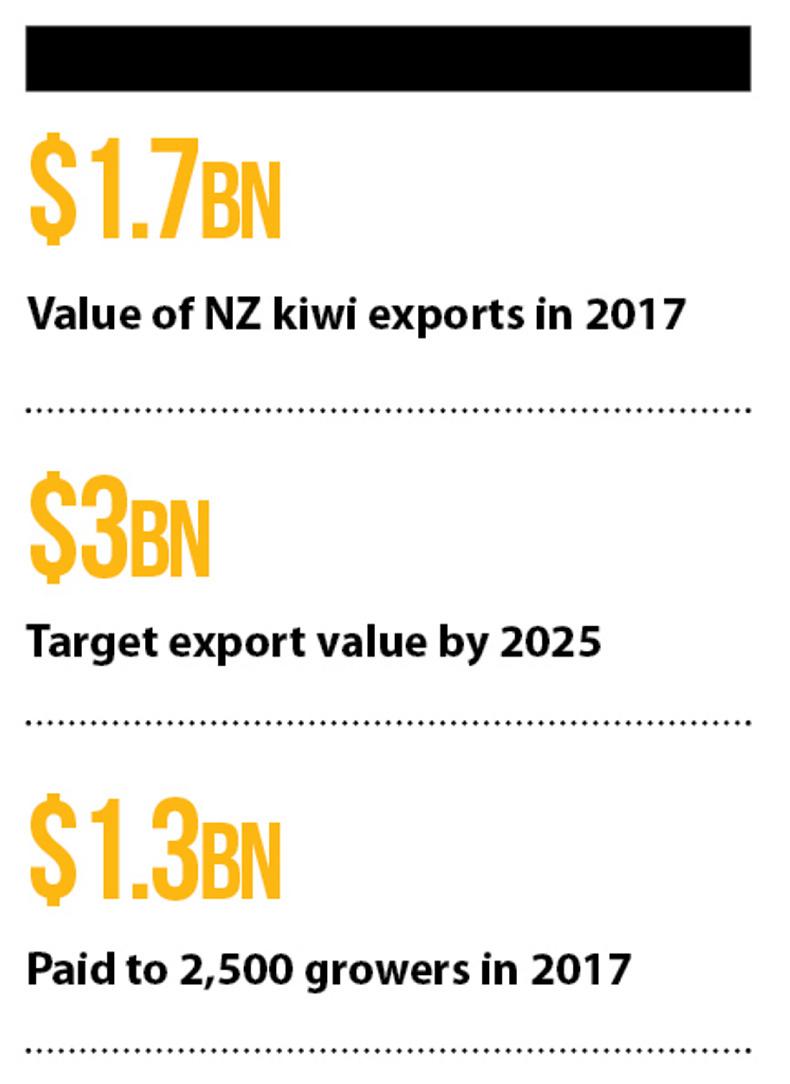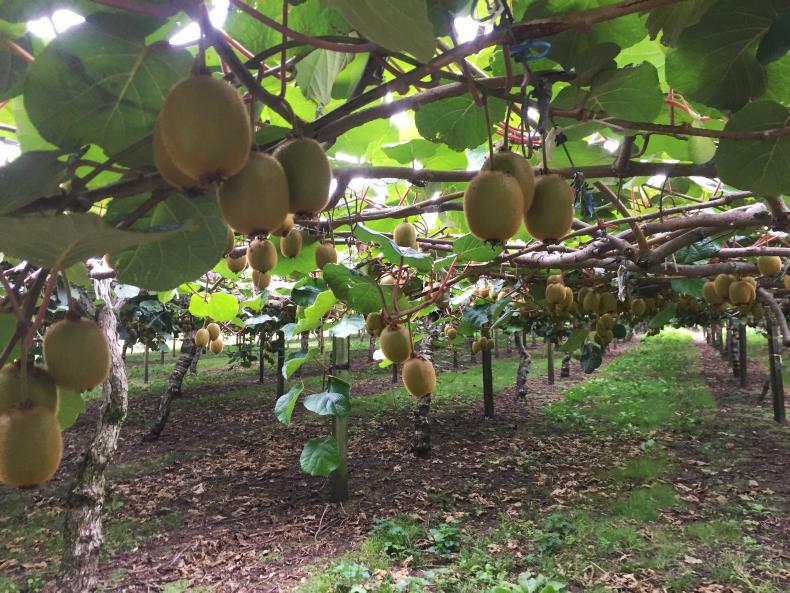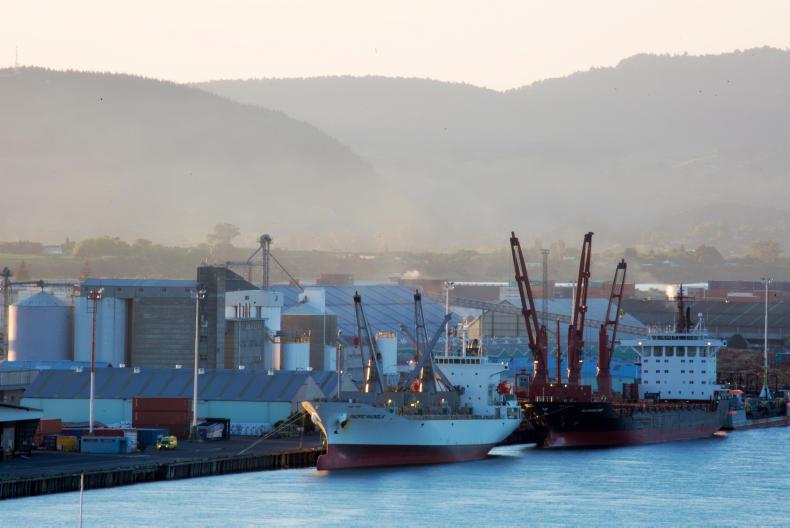If you’ve ever eaten a kiwi fruit, chances are you’ve had one grown in the sleepy town of Te Puke, located on the North Island of New Zealand. Te Puke is the heart and soul of kiwi fruit production, not just in New Zealand but the world over. A giant welcome sign moulded in the shape of a sliced kiwifruit welcomes visitors to the town, which is appropriate for a place that markets itself to visitors as the “kiwi fruit capital of the world”.

But behind the tourism benefits and the thousands of seasonal workers that arrive for the annual harvest in March every year, the story of New Zealand’s kiwi fruit industry in one of remarkable innovation, especially given the commodity nature of producing fruit.
Since 2010, New Zealand’s kiwi fruit industry has seen annual exports grow at a compound rate of 13% to reach NZ$1.7bn (€1bn) in 2017. Last year was the first time kiwi exports overtook New Zealand wine exports, marking a significant milestone for the sector. A target of more than NZ$3bn (€1.8bn) has been set for kiwi fruit exports from New Zealand by 2025. Zespri, the grower-owned exporter of New Zealand kiwi fruit, has driven much of this export growth with a particular focus on innovating its product offering for the global market. To differentiate in a commodity fruit market, Zespri invests heavily in the breeding and development of new varieties.

Zespri purchased 138m trays of kiwifruit from its growers in 2017.
Gold variety
The company first tasted success in breeding new varieties in the 1990s when it developed a new kiwi fruit variety that was gold in colour. This differentiated variety immediately separated the company’s product offering from the standard commodity green kiwi fruit. On the back of this new coloured variety, Zespri established the Zespri Gold brand in the late 1990s, which has allowed it to further position itself in a premium segment of the commodity kiwi fruit market. The brand typically allows Zespri to charge prices that are 60% to 100% above the commodity sales price of green kiwi fruit.
In 2017, over €400m was paid out to green kiwi fruit growers in New Zealand, which equates to an average per hectare return of almost NZ$54,000 (€32,000).
The company is also able to sell the licensing of the gold variety to growers outside New Zealand, particularly those in the northern hemisphere, where their counter-seasonal production will not affect Zespri sales.
Zespri received more than NZ$67m (€40m) in income from the sale of variety licences last year, with growers in Europe the main buyers. Zespri estimates the gold variety will return NZ$40bn (€24bn) to the New Zealand economy over its lifetime. The plant variety rights (PVR) on the gold variety will expire in 2035. The commercial success of the gold variety has encouraged Zespri to continuously invest in its plant breeding pipeline to develop further innovations.

An orchard of green kiwifruit in Te Puke, New Zealand.
Each year, the company typically invests NZ$20m (€12m) in new plant breeding with 100,000 new varieties being developed at any one time at Zespri’s 50ha research and development orchard on the outskirts of Te Puke.
Zespri’s plant breeding programme is the biggest and longest running of its type in the world, with the aim of keeping ahead of competitors.
Returns
The company understands it takes just one successful new variety to be developed from this pipeline to deliver a significant return on investment. Without the returns delivered by the gold variety since the 1990s, the University of Waikato estimates New Zealand’s kiwi fruit industry would be less than half of what it is today.
The next big innovation coming to the market from Zespri’s plant breeding programme will be a red variety of kiwifruit. The company says it currently has three red kiwi fruit varieties that are in the pre-commercial phase of development and likely to become available to commercial growers within the next two years. If any of these new red varieties can deliver a percentage of the NZ$40bn returned by the gold variety, Zespri will consider the investment a success.
For New Zealand’s kiwi fruit growers, the continuous research carried out by Zespri into new varieties has allowed their businesses to flourish. The focus on R&D has risen all boats in what was traditionally a commodity sector.
In 2017, Zespri paid out NZ$1.3bn (€800m) to its 2,500 growers in New Zealand in return for the 138m trays of kiwi fruit supplied during the year. Almost half of this, or NZ$600m (€355m), was paid out to growers for gold kiwi fruit, even though gold varieties account for just a third of Zespri’s supply.

Zespri exports New Zealand kiwifruit to markets all around the world, where Zespri products sell for 60% to 100% above the commodity kiwifruit price.
The average per hectare return from supplying gold varieties was almost NZ$100,000 (€60,000) last year, according to Zespri. This is up from €42,000/ha the previous year, mainly driven by record yields for gold varieties.
The majority of kiwi fruit supplied to Zespri (60%) is still the standard green variety. However, the added value created by the gold variety allows Zespri to deliver superior returns to its green variety growers.
In 2017, over €400m was paid out to green kiwi fruit growers in New Zealand, which equates to an average per hectare return of almost NZ$54,000 (€32,000). This is the third consecutive year that returns for supplying standard green kiwifruit have been above NZ$50,000/ha. With about 90% of Zespri’s supply of green and 75% of its supply of gold kiwi fruit produced in the Bay of Plenty, these strong returns to growers are a huge financial injection into the rural economy of New Zealand every year.
Challenges
However, the success of the Zespri model has created its own unique challenges for kiwi fruit growers. With the farmer co-op delivering such attractive returns to growers, many new entrants are eager to join the sector and start growing kiwi fruit, particularly if they can get a licence to grow the gold variety.
But with kiwifruit production centred in the Bay of Plenty region, this new wave of interest has caused the local land market to balloon. Land prices in the Bay of Plenty have risen to an average of NZ$80,000/ha (€50,000/ha), while around Te Puke deals have recently been done for gold orchards for as much as NZ$1m/ha (€600,000/ha).
While a rising asset value is a positive for existing growers, it has created significant barriers to entry for younger growers seeking to enter the sector. With New Zealand dairying having lost its shine due to environmental concerns and low milk prices, the kiwi fruit sector has become increasingly attractive for investment funds.

With New Zealand dairying having lost its shine due to environmental concerns and low milk prices, the kiwifruit sector has become increasingly attractive for investment funds.
MyFarm Investments, a rural-focused investment fund with €300m under management, has moved its focus away from its dairy farming origins over the last year and is increasingly putting its investors’ money into horticulture, particularly kiwi fruit.
Cash returns from horticulture can be as high as 15%, which is significantly better than the 4% returns available in dairying at the moment.
The average kiwi fruit orchard in the Bay of Plenty is between 3ha and 3.5ha. However, commercial orchards up to 100ha in size have sprung up in the Bay of Plenty region over recent years as the investment money flows in.
The business model and innovation pipeline created by Zespri makes sense for investors and looks set to deliver in the years ahead. The kiwi fruit gold rush is well under way.
If you’ve ever eaten a kiwi fruit, chances are you’ve had one grown in the sleepy town of Te Puke, located on the North Island of New Zealand. Te Puke is the heart and soul of kiwi fruit production, not just in New Zealand but the world over. A giant welcome sign moulded in the shape of a sliced kiwifruit welcomes visitors to the town, which is appropriate for a place that markets itself to visitors as the “kiwi fruit capital of the world”.

But behind the tourism benefits and the thousands of seasonal workers that arrive for the annual harvest in March every year, the story of New Zealand’s kiwi fruit industry in one of remarkable innovation, especially given the commodity nature of producing fruit.
Since 2010, New Zealand’s kiwi fruit industry has seen annual exports grow at a compound rate of 13% to reach NZ$1.7bn (€1bn) in 2017. Last year was the first time kiwi exports overtook New Zealand wine exports, marking a significant milestone for the sector. A target of more than NZ$3bn (€1.8bn) has been set for kiwi fruit exports from New Zealand by 2025. Zespri, the grower-owned exporter of New Zealand kiwi fruit, has driven much of this export growth with a particular focus on innovating its product offering for the global market. To differentiate in a commodity fruit market, Zespri invests heavily in the breeding and development of new varieties.

Zespri purchased 138m trays of kiwifruit from its growers in 2017.
Gold variety
The company first tasted success in breeding new varieties in the 1990s when it developed a new kiwi fruit variety that was gold in colour. This differentiated variety immediately separated the company’s product offering from the standard commodity green kiwi fruit. On the back of this new coloured variety, Zespri established the Zespri Gold brand in the late 1990s, which has allowed it to further position itself in a premium segment of the commodity kiwi fruit market. The brand typically allows Zespri to charge prices that are 60% to 100% above the commodity sales price of green kiwi fruit.
In 2017, over €400m was paid out to green kiwi fruit growers in New Zealand, which equates to an average per hectare return of almost NZ$54,000 (€32,000).
The company is also able to sell the licensing of the gold variety to growers outside New Zealand, particularly those in the northern hemisphere, where their counter-seasonal production will not affect Zespri sales.
Zespri received more than NZ$67m (€40m) in income from the sale of variety licences last year, with growers in Europe the main buyers. Zespri estimates the gold variety will return NZ$40bn (€24bn) to the New Zealand economy over its lifetime. The plant variety rights (PVR) on the gold variety will expire in 2035. The commercial success of the gold variety has encouraged Zespri to continuously invest in its plant breeding pipeline to develop further innovations.

An orchard of green kiwifruit in Te Puke, New Zealand.
Each year, the company typically invests NZ$20m (€12m) in new plant breeding with 100,000 new varieties being developed at any one time at Zespri’s 50ha research and development orchard on the outskirts of Te Puke.
Zespri’s plant breeding programme is the biggest and longest running of its type in the world, with the aim of keeping ahead of competitors.
Returns
The company understands it takes just one successful new variety to be developed from this pipeline to deliver a significant return on investment. Without the returns delivered by the gold variety since the 1990s, the University of Waikato estimates New Zealand’s kiwi fruit industry would be less than half of what it is today.
The next big innovation coming to the market from Zespri’s plant breeding programme will be a red variety of kiwifruit. The company says it currently has three red kiwi fruit varieties that are in the pre-commercial phase of development and likely to become available to commercial growers within the next two years. If any of these new red varieties can deliver a percentage of the NZ$40bn returned by the gold variety, Zespri will consider the investment a success.
For New Zealand’s kiwi fruit growers, the continuous research carried out by Zespri into new varieties has allowed their businesses to flourish. The focus on R&D has risen all boats in what was traditionally a commodity sector.
In 2017, Zespri paid out NZ$1.3bn (€800m) to its 2,500 growers in New Zealand in return for the 138m trays of kiwi fruit supplied during the year. Almost half of this, or NZ$600m (€355m), was paid out to growers for gold kiwi fruit, even though gold varieties account for just a third of Zespri’s supply.

Zespri exports New Zealand kiwifruit to markets all around the world, where Zespri products sell for 60% to 100% above the commodity kiwifruit price.
The average per hectare return from supplying gold varieties was almost NZ$100,000 (€60,000) last year, according to Zespri. This is up from €42,000/ha the previous year, mainly driven by record yields for gold varieties.
The majority of kiwi fruit supplied to Zespri (60%) is still the standard green variety. However, the added value created by the gold variety allows Zespri to deliver superior returns to its green variety growers.
In 2017, over €400m was paid out to green kiwi fruit growers in New Zealand, which equates to an average per hectare return of almost NZ$54,000 (€32,000). This is the third consecutive year that returns for supplying standard green kiwifruit have been above NZ$50,000/ha. With about 90% of Zespri’s supply of green and 75% of its supply of gold kiwi fruit produced in the Bay of Plenty, these strong returns to growers are a huge financial injection into the rural economy of New Zealand every year.
Challenges
However, the success of the Zespri model has created its own unique challenges for kiwi fruit growers. With the farmer co-op delivering such attractive returns to growers, many new entrants are eager to join the sector and start growing kiwi fruit, particularly if they can get a licence to grow the gold variety.
But with kiwifruit production centred in the Bay of Plenty region, this new wave of interest has caused the local land market to balloon. Land prices in the Bay of Plenty have risen to an average of NZ$80,000/ha (€50,000/ha), while around Te Puke deals have recently been done for gold orchards for as much as NZ$1m/ha (€600,000/ha).
While a rising asset value is a positive for existing growers, it has created significant barriers to entry for younger growers seeking to enter the sector. With New Zealand dairying having lost its shine due to environmental concerns and low milk prices, the kiwi fruit sector has become increasingly attractive for investment funds.

With New Zealand dairying having lost its shine due to environmental concerns and low milk prices, the kiwifruit sector has become increasingly attractive for investment funds.
MyFarm Investments, a rural-focused investment fund with €300m under management, has moved its focus away from its dairy farming origins over the last year and is increasingly putting its investors’ money into horticulture, particularly kiwi fruit.
Cash returns from horticulture can be as high as 15%, which is significantly better than the 4% returns available in dairying at the moment.
The average kiwi fruit orchard in the Bay of Plenty is between 3ha and 3.5ha. However, commercial orchards up to 100ha in size have sprung up in the Bay of Plenty region over recent years as the investment money flows in.
The business model and innovation pipeline created by Zespri makes sense for investors and looks set to deliver in the years ahead. The kiwi fruit gold rush is well under way.











 This is a subscriber-only article
This is a subscriber-only article














SHARING OPTIONS: